
The article is about some of the most famous works by B.V Doshi.
B. V Doshi (Balkrishna Vithaldas Doshi) is unequivocally a towering figure in Indian architecture.He is hailed for his groundbreaking contributions that have redefined architectural discourse within the country. He had a prestigious academic and professional pedigree.
He recieved mentorship under architectural luminaries such as Le Corbusier and Louis Kahn. Doshi emerged as a trailblazer of modernist and brutalist architecture in India, consistently pushing boundaries and challenging conventional norms.
In recognition of his remarkable influence and innovative vision, Doshi made history in 2018 by becoming the first Indian architect to receive the esteemed Pritzker Architecture Prize, underscoring his global significance.
This accolade is just one among many honors he accumulated throughout his distinguished career, including the Padma Shri, Padma Bhushan, Padma Vibhushan, and the Royal Institute of British Architects’ Royal Gold Medal for 2022.
Born in Pune, India, Doshi laid the foundation of his career at the J.J. School of Architecture in Mumbai. He furthered his education at the Illinois Institute of Technology in the United States, where he studied under the legendary architect Ludwig Mies van der Rohe. This transformative period in the U.S. profoundly influenced his architectural philosophy.
He returned to India with a wealth of knowledge, eager to incorporate the principles of modernism into his work while responding to local needs and contexts.
Beyond his stature as an architect, Doshi also embodies the role of a visionary educator and institution-builder. He was pivotal in establishing the School of Architecture, Ahmedabad (1962–72), a cornerstone of architectural education in India, and he played a foundational role in the School of Planning (1972–79) and the Centre for Environmental Planning and Technology (1972–81).
His profound impact also extends to the arts, where he was instrumental in founding the Visual Arts Centre and the Kanoria Centre for Arts in Ahmedabad.
Doshi’s commitment to social issues is exemplified by his founding of the Vastu-Shilpa Foundation for Studies and Research in Environmental Design, a premier research institute that has gained nationwide and international acclaim.
This institute has pioneered vital research in low-cost housing and urban planning, asserting his dedication to crafting designs that are not only aesthetically pleasing but also socially responsible and ecologically sustainable.
The following article delves into ten of Doshi’s most iconic architectural creations, each of which exemplifies his innovative spirit and has left a lasting impression on architectural thought and practice.
**1. Aranya Low Cost Housing, Indore**
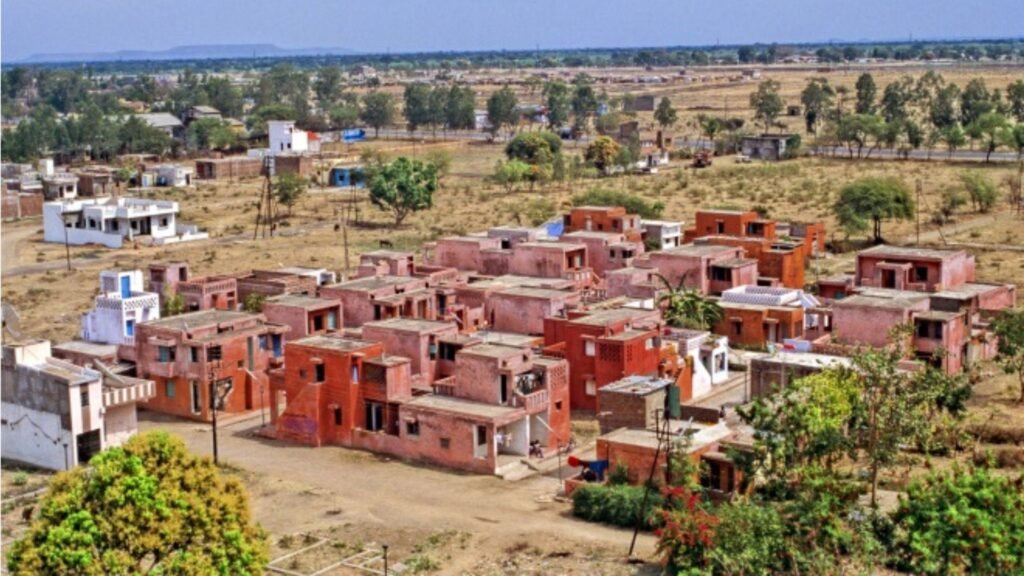
Completed in 1989, the Aranya township stands as a stellar testament to Doshi’s design. His philosophy was to prioritizes community cohesion and harmony with the surrounding environment. This innovative project, awarded the prestigious Aga Khan Award for Architecture in 1996, serves as a model for providing affordable housing solutions to low-income families.
The Aranya development was meticulously designed to utilize low-cost materials and construction techniques while addressing the specific needs of its residents. Thoughtfully organized, the township fosters community interaction and promotes a sense of belonging among its inhabitants.
In addition to affordability, the design emphasizes environmental sustainability through features such as solar water heaters and rainwater harvesting systems. The clean lines and simple forms of the buildings create an aesthetic of timelessness, highlighting Doshi’s commitment to both form and function.
**2. Indian Institute of Management (IIM) Ahmedabad**
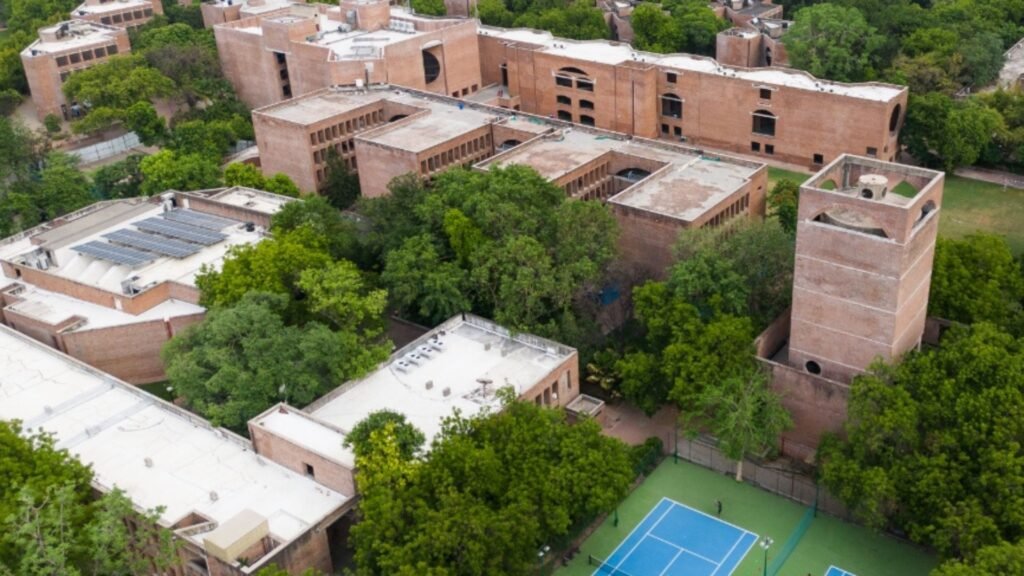
Indian Institute of Management (IIM) Ahmedabad serves as a cultural patrimony in Ahmedabad. It was crafted with precision by B.V. Doshi . This project marked a pivotal moment in his career, representing one of his significant public contributions after his tenure with Le Corbusier.
The design intricately integrates with the natural environment, optimizing its form and orientation to harness the benefits of natural light, enhance ventilation, and invite the refreshing breeze. Employing passive cooling strategies, such as thick walls and shaded terraces, the building achieves a sustainable climate control mechanism. This diminishes the dependence on conventional air conditioning systems.
Characterized by traditional building techniques and materials—including exposed brick and local stones—the structure resonates with its cultural context, establishing a strong connection between the architecture and the landscape.
Furthermore, features like the podium and veranda pay homage to traditional Indian architectural elements while incorporating a Jain upashraya, a monk’s residence that Doshi meticulously studied, enriching the spiritual and cultural dimensions of the design.
**3. Amdavad ni Gufa, Ahmedabad **
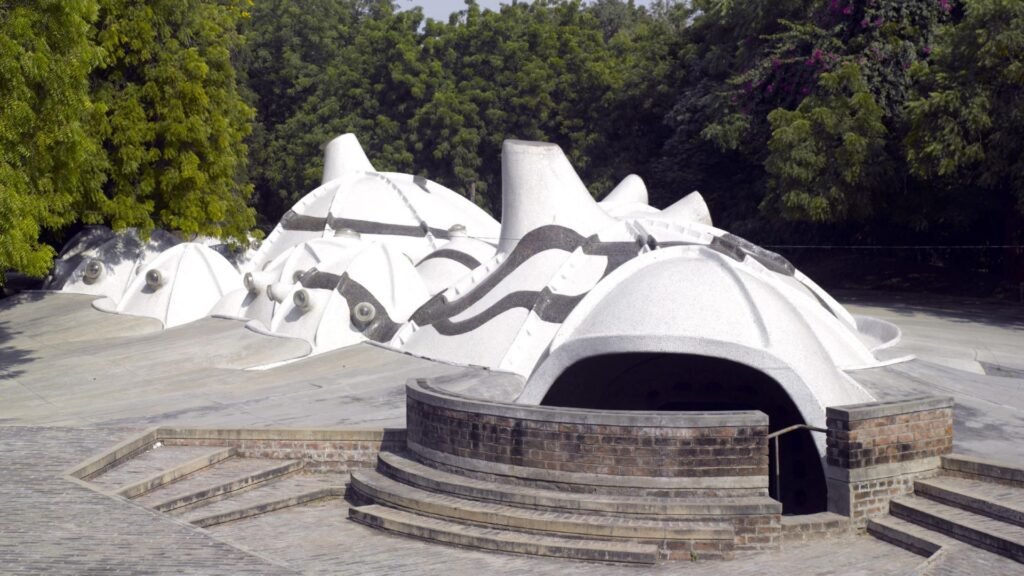
Amdavad ni Gufa is an extraordinary underground art gallery located in Ahmedabad, Gujarat, India, . It is a testament to the pioneering vision of the esteemed architect B.V. Doshi.
This distinctive gallery prominently features an impressive collection of works by the iconic Indian artist Maqbool Fida Husain. It has garnered acclaim for its innovative architectural design and exceptional use of natural light.
The gallery’s structure embodies contemporary architecture while paying homage to ancient and natural themes. Notably, its domes draw inspiration from the graceful shapes of tortoise shells and the ephemeral forms of soap bubbles, creating an aesthetic that is both organic and striking.
Built subterraneously, the gallery consists of a labyrinth of interconnected caves and caverns, meticulously crafted to offer visitors a truly immersive and unforgettable experience.
The cave-like spaces utilize raw exposed concrete, enhancing the organic texture and atmosphere of the gallery, while also seamlessly integrating the artworks into their natural surroundings.
Natural light is an integral element of the design, with strategically placed skylights and light wells that infuse the galleries with sunlight. This design not only creates a vital connection to the outside world but also contributes to an energy-efficient environment by significantly reducing the need for artificial lighting.
To access the gallery, visitors navigate a partially concealed staircase that leads to a meticulously crafted circular door, which opens into the enchanting cave-like environment.
Although primarily designed to display paintings, the space breaks from traditional architecture; the absence of straight walls fosters a seamless flow, with the curved dome structure extending gracefully down to meet the floor.
The domes are supported by irregularly shaped, inclined columns that evoke the grandeur of a natural cave and resemble the sturdy trunks of trees. The overall design elegantly combines circles and ellipses, showcasing a mastery of organic architectural principles.
As sunlight filters through the snouts, it casts fluid patterns of light and shadow on the floor, transforming the space throughout the day and enhancing its mystical ambiance.
**4.National Institute of Fashion Technology (NIFT) Campus, Gandhinagar**

The NIFT campus located in Gandhinagar. It is widely recognized for its innovative architectural design and unwavering commitment to sustainable practices.
Not only does the campus boast environmentally friendly features such as solar water heaters and advanced rainwater harvesting systems, but it also strategically utilizes natural light and ventilation. This reduces reliance on artificial lighting and air conditioning, creating a comfortable indoor climate.
The thoughtful incorporation of lush open spaces and meticulously landscaped gardens further enhances the campus. Hence fostering a deep connection to nature and providing a serene and pleasant environment for both students and staff.
The architecture of the campus is distinguished by its use of traditional building techniques and locally sourced materials like exposed brick and stone. This design approach gives the campus a distinctive visual character.
But also strengthens its connection to the rich local context and cultural heritage of the region. With an emphasis on craftsmanship, the design showcases meticulous attention to detail, featuring clean lines and minimalist forms that lend the campus a timeless elegance.
The NIFT Gandhinagar campus is equipped with state-of-the-art facilities that cater specifically to the needs of its students and faculty. These include 25 well-appointed classrooms and studios, 24 fully equipped lab workshops, three audio-visual rooms, and two IT conference and video conferencing rooms.
These rooms are specifically designed for primary academic activities. The campus also features a Resource Centre and Library, as well as a Design Studio that serve as vital hubs for academic endeavor and research collaboration.
Emphasizing a student-centric approach, NIFT Gandhinagar fosters a vibrant and diverse array of extracurricular activities supported by extensive facilities.
The campus includes an Auditorium with a seating capacity of 339, a Student Activity Centre with an amphitheater, and various sports amenities such as a Badminton Court, Basketball Court, Volleyball Court, Cricket Pitch, Table Tennis room, Music Room, and Dance Room. This comprehensive range of facilities encourages holistic development among students.
The Campus Auditorium, capable of hosting around 350 participants, serves as a venue for significant events organized by NIFT Gandhinagar and various other organizations, making it a hub for community engagement and interaction.
Additionally, through collaboration with the Gujarat Energy Research and Management Institute (GERMI), five solar photovoltaic (PV) bench modules have been installed on campus under the Indo-German Energy Programme facilitated by GIZ (Deutsche Gesellschaft für Internationale Zusammenarbeit).
These solar benches generate renewable energy and are equipped with multiple power outlets, allowing students to charge laptops and mobile devices conveniently, thus enhancing their learning experience.
**5. Indian Institute of Management (IIM), Bangalore**
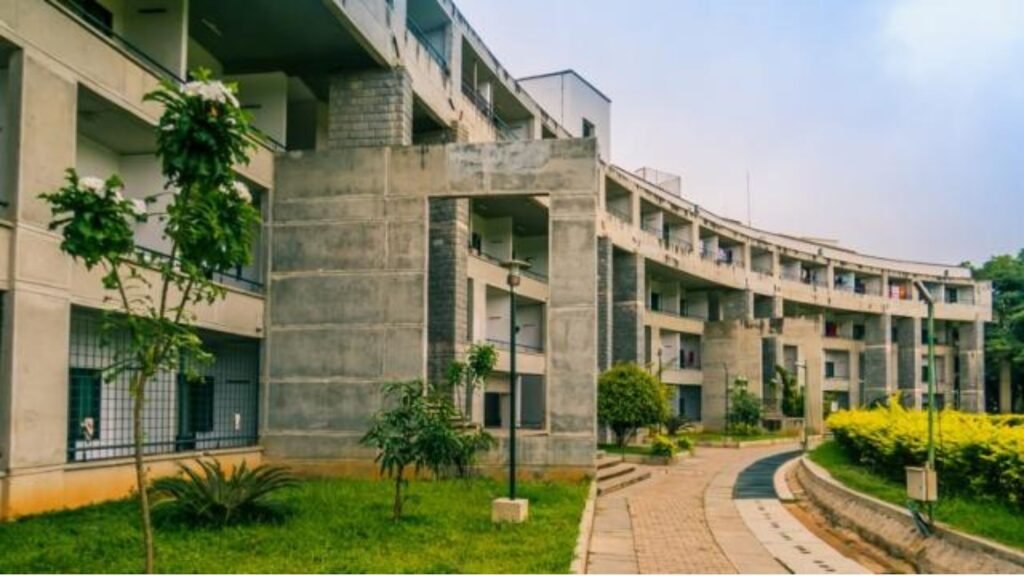
The Indian Institute of Management, Bangalore (IIMB) is designed by B.V Doshi. It features a striking 54,000 square meter complex that occupies an expansive 100-acre campus, drawing inspiration from the historical layout of Fatehpur Sikri, which was meticulously designed by the Mughal emperor Akbar in the 16th century.
B.V Doshi brilliantly materialized this historical concept by creating an intricate network of corridors, courtyards, and external spaces. That not only facilitate the present academic environment but also accommodate future developments. Thus ensuring the campus evolves with time.
Architecturally, IIMB stands out for its innovative use of traditional building techniques and locally sourced materials, such as exposed brick and natural stone.
This choice not only enhances the aesthetic appeal of the campus but also forges a strong connection to the local context and culture. The design is characterized by meticulous attention to detail. Exemplified in the clean lines and minimalist forms that enhance its timeless elegance.
The campus design prioritizes sustainability and a seamless integration with the surrounding natural landscape. It incorporates advanced environmentally friendly features, including passive cooling systems that significantly lessen the dependency on artificial air conditioning, and strategically placed windows and openings that harness natural light and ventilation.
The layout includes numerous open spaces and carefully landscaped gardens, which serve to deepen the connection between students, staff, and nature. Hence creating an enriched environment that fosters learning and collaboration.
The corridors serve as conduits for academic interaction, extending conversations and collaborations beyond the walls of traditional classrooms.
The architectural design of IIMB exemplifies Doshi’s keen understanding of scale, proportion, and the transformative effects of light. The intricate interplay of walls and openings alters the character of the main building throughout the day and across various seasons, creating a dynamic visual experience.
Key features of this ‘glocal’ design include three-storied hallways, expansive quadrangles adorned with lush greenery, sunlight streaming through artfully designed pergolas, geometrical roofs, and a richly textured finish.
IIMB’s architectural approach exemplifies an acute awareness of historical influences while fostering a symbiotic relationship with contemporary needs. As B.V Doshi articulated, the objective was “to create an atmosphere where you don’t see divides and doors,” promoting an inclusive and interconnected educational environment.
**6. Tagore Hall, Ahmedabad**
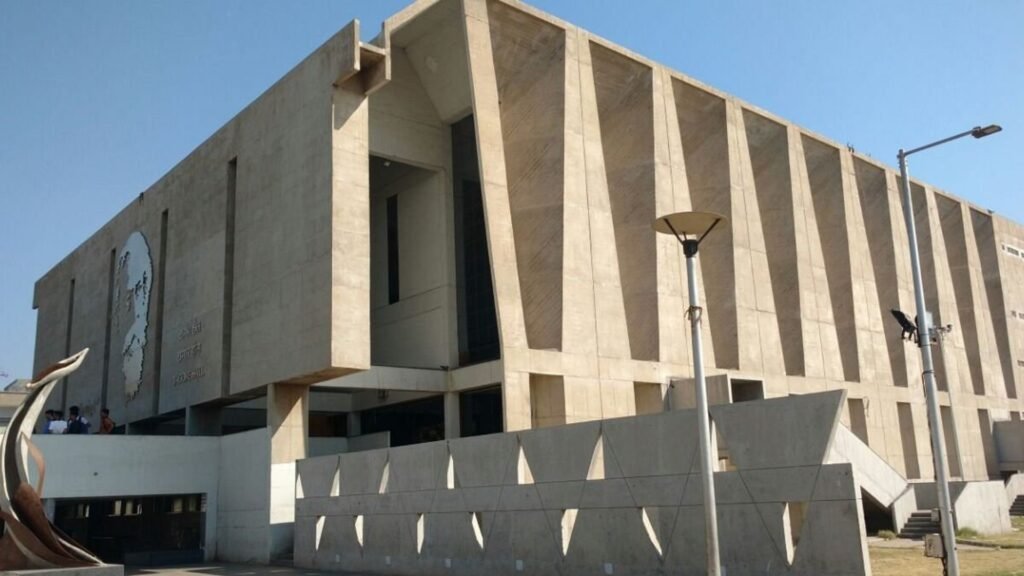
Tagore Hall is a pronounced example of Brutalist architecture. It is defined by its series of rigid concrete folded plates that form a bold outer shell.
Designed by B.V Doshi in 1966, this hall occupies a strategic location on the banks of the Sabarmati River. It features a ‘seating bowl’ that accommodates up to 700 individuals. Hence making it a premier venue for a variety of events, performances, and cultural gatherings.
The hall’s architectural style blends traditional elements with modern design principles.Hence creating a unique character that resonates deeply with the local context and culture. The design is underscored by a meticulous commitment to detail. Clean lines and simple forms contribute to the hall’s enduring and sophisticated quality.
Envisioned as a cultural center, Tagore Hall includes a diverse array of rooms and multifunctional spaces. Tailored for an extensive range of activities, from lectures to art exhibitions.
The integration of open spaces and lush gardens accentuates the hall’s architecture, promoting an engaging and vibrant connection to the natural environment. Hence further enhancing the experience for visitors.
A central courtyard, surrounded by the hall’s diverse spaces, serves as the heart of the building. This infuses natural light and fresh air into the interior spaces. This courtyard also functions as a dynamic gathering area, fostering social interactions and cultural exchanges among visitors.
**7. Premabhai Hall, Ahmedabad**
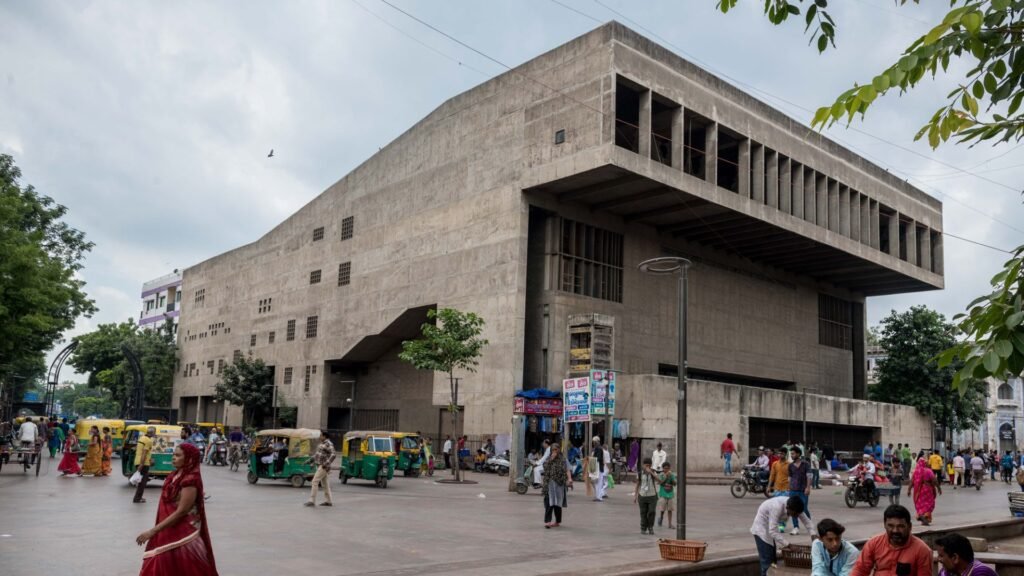
Premabhai Hall serves as a distinguished cultural center and community hub in Ahmedabad, Gujarat, India. Meticulously designed by the esteemed architect B.V Doshi. Erected in 1956, this exemplary post-Corbusian Brutalist structure is predominantly composed of reinforced concrete. Hence epitomizing modern public theater architecture.
The building includes a spacious auditorium equipped with advanced acoustics, expansive corridors that allow for fluid movement. There are dedicated areas where the public and artists can convene and collaborate. Its architectural language is characterized by the deliberate use of exposed brick and natural stone.
Hence lending the hall a distinct personality that is deeply rooted in the local cultural context. The attention to detail is evident in the clean lines and geometric simplicity of the design. Together they confer a timeless elegance. Additionally, the roof offers a panoramic view of the vibrant historical surroundings, enhancing the sensory experience of the space.
Although the theater ceased operations in 1997, the architectural volume of Premabhai Hall continues to assert its presence. Hence actively contributing to the character of its architectural context and shaping public spaces in the area.
**8. Sangath, B.V. Doshi’s Office, Ahmedabad**
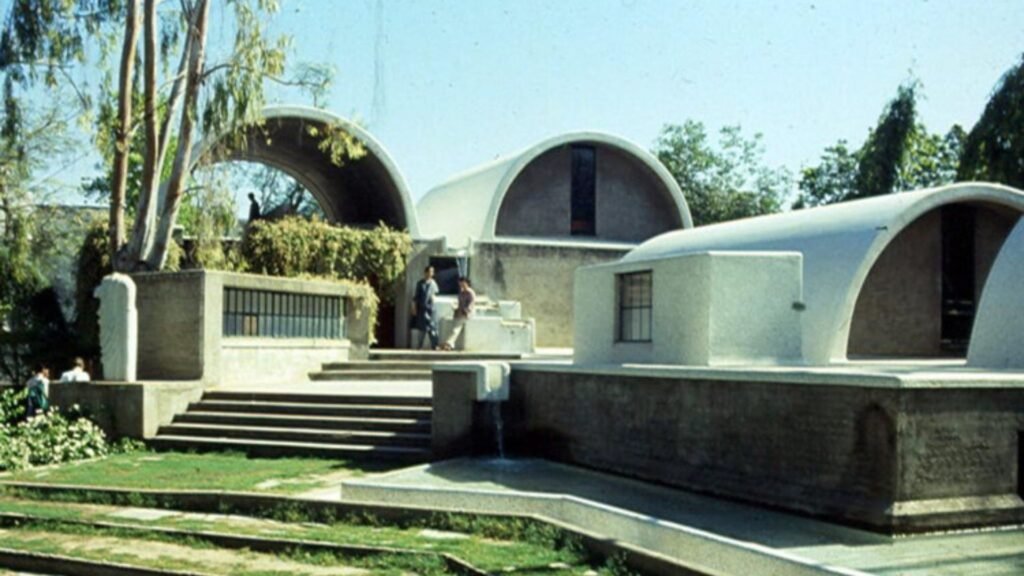
Sangath is not merely an office. It is a brilliant studio conceived by architect B.V Doshi in Ahmedabad, India. Completed in 1981, this complex features a series of striking white, curved vaults interspersed with arched openings. Hence showcasing Doshi’s architectural philosophy that harmonizes with both form and function.
The studio is remarkable for its innovative use of vaulted structures. Cladded in reflective white tiles designed to optimize light and heat management. Incorporating advanced passive cooling techniques such as earth-sheltered spaces and strategically bermed structures.
Sangath ensures exceptional thermal insulation throughout the year. Key design features, such as elegantly sunken spaces, inviting terraces. Carefully considered indirect daylighting enhance the flow of natural light and air circulation.
In a blend of Indian traditional materials with contemporary architectural techniques, Sangath reflects Doshi’s deep commitment to community-centric design. They intentionally set the vaults into the earth. Hence enhancing their prominence and creating ideal spaces for outdoor activities.
A thoughtfully designed terraced amphitheater offers a dedicated venue for lectures and community gatherings. A serene flowing water features amplify the tranquil ambiance. This contributes to a favorable microclimate around the structure. The exterior, adorned with intricate china mosaic, adds a layer of visual complexity and brilliance to the building’s overall aesthetic.
**9. Life Insurance Corporation Housing Colony, Ahmedabad**
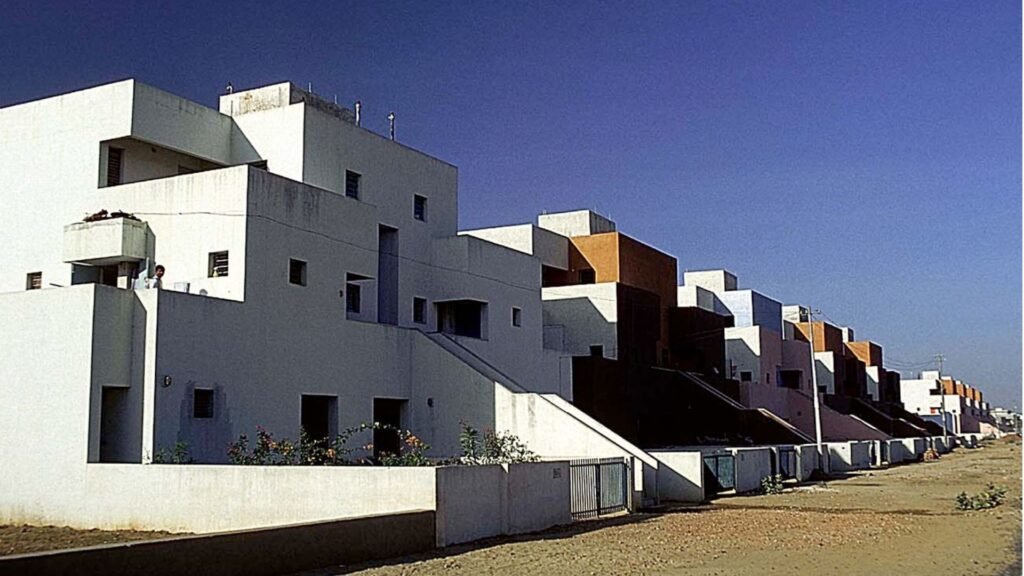
The visionary architect B.V Doshi masterfully designed the Life Insurance Corporation(LIC) Housing project inAhmedabad in1973.. It stands as an iconic development. Which effectively accommodates diverse income groups within a cohesive residential community. The project is located in Bhimnagar. This ambitious project encompasses 324 duplex units meticulously organized across 54 individual plots, showcasing a novel approach to communal living.
The architect intelligently arranged the residences in a pyramidal configuration.It allows access via a central staircase that enhances connectivity. The largest units occupy the lower levels, providing advantageous living arrangements for families.
The upper units enjoy exclusive rooftop terraces perfect for relaxation and outdoor enjoyment. The design fosters a sense of community . With the inclusion of common areas such as children’s playgrounds, lush parks, and communal meeting spaces.
A sophisticated central rain water harvesting system supports all and exemplifies sustainable practices. Over time, residents have modifed their units by adding rooms and redesigning balconies. This highlights the project’s adaptability and encourages a profound sense of community belonging.
The project ingeniously integrates three distinct income groups, reflecting a diverse array of ownership patterns that enhance social interaction. Shared courtyards and interactive communal spaces create opportunities for networking and engagement among residents. The incorporation of a central rainwater harvesting system underscores the project’s unwavering commitment to sustainability and responsible resource management.
10.CEPT University, Ahmedabad

Nestled in the vibrant city of Ahmedabad, Gujarat, India, the CEPT University campus stands as a testament to the visionary brilliance of the esteemed architect B.V Doshi. The campus unfolded over several years, beginning in the early 1960s, evolving into a space that seamlessly blends architecture with nature.
The community celebrates the CEPT University campus not only for its innovative architectural design but also for its steadfast commitment to sustainability.Each architect thoughtfully integrates the structures into the surrounding landscape.
This promotes a sense of harmony with the environment. This is achieved through the incorporation of several environmentally sustainable design elements. The elements includes like passive cooling techniques that significantly reduce the reliance on air conditioning . Strategic use of natural light and ventilation to create inviting learning spaces.
Drawing inspiration from architectural giants like Le Corbusier and Louis I. Kahn, Doshi crafted a campus characterized by parallel brick walls and robust concrete columns. B.V Doshi’s design minimizes direct sunlight .
It enhances natural airflow, creating a cool and comfortable environment conducive to study and creativity. By addressing Ahmedabad’s climate, Doshi envisioned a hub where shade and gentle breezes converge. Hence offering a refreshing atmosphere for all who engage within its walls.
The architecture of CEPT University is more than just aesthetic . The designers aim to foster both formal and informal education.
Hence making it as one of the most coveted institutions for students aspiring to excel architecture and design. Asa result it stands as a beacon of learning and creativity also inviting future generations to explore and innovate within its thoughtfully conceived spaces.
B.V Doshi’s efforts to unite Indian and English heritages through his architectural practice garnered him the Global Award for Sustainable Architecture in 2007. It was the inaugural edition of the award.
This recognition highlighted Doshi’s significant contribution towards developing an alternative model for architecture. In March 2018, they awarded him the prestigious Pritzker Architecture Prize, often considered the Nobel equivalent in the field, making him the first Indian to receive this honor.
Read about 10 noteworthy cities and towns of Telangana
